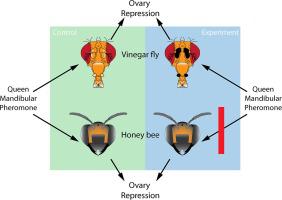Journal of Insect Physiology ( IF 2.3 ) Pub Date : 2020-10-08 , DOI: 10.1016/j.jinsphys.2020.104154 M.R. Lovegrove , R.A. Knapp , E.J. Duncan , P.K. Dearden

|
Eusociality is characterised by the reproductive division of labour; a dominant female (queen) or females are responsible for the majority of reproduction, and subordinate females are reproductively constrained. Reproductive constraint can be due to behavioural aggression and/or chemical cues, so-called queen pheromones, produced by the dominant females. In the honeybee, Apis mellifera, this repressive queen pheromone is queen mandibular pheromone (QMP). The mechanism by which honeybee workers are susceptible to QMP is not yet completely understood, however it is thought to be through olfaction via the antennae and/or gustation via trophallaxis.
We have investigated whether olfaction is key to sensing of QMP, using both Drosophila melanogaster- a tractable non-eusocial insect which is also reproductively repressed by QMP- and the target species, A. mellifera worker honeybees. D. melanogaster are still capable of sensing and responding to QMP without their antenna and maxillary palps, and therefore without olfactory receptors. When worker honeybees were exposed to QMP but unable to physically interact with it, therefore required to use olfaction, they were similarly not reproductively repressed. Combined, these findings support either a non-olfactory based mechanism for the repression of reproduction via QMP, or redundancy via non-olfactory mechanisms in both D. melanogaster and A. mellifera. This study furthers our understanding of how species are susceptible to QMP, and provides insight into the mechanisms governing QMP responsiveness in these diverse species.
中文翻译:

果蝇和工蜂(Apis mellifera)不需要嗅觉即可感染蜂王后下颌信息素。
嘲讽的特征是生殖分工;一个主要的雌性(雌性)或雌性负责大部分繁殖,而从属雌性则受到繁殖的限制。生殖限制可以归因于占主导地位的雌性产生的行为攻击和/或化学暗示,即所谓的女王信息素。在蜜蜂Apis mellifera中,这种抑制性女王信息素是下颌女王信息素(QMP)。蜜蜂工人易受QMP侵害的机制尚未完全了解,但是据认为是通过触角嗅觉和/或通过斜向性嗅觉引起的。
我们已经研究了嗅觉对于使用果蝇(Drosophila melanogaster)和目标物种A. mellifera worker蜜蜂是否都对QMP的检测至关重要,而果蝇是一种易处理的非共生昆虫,也受到QMP的抑制。D. melanogaster仍然能够感应QMP并对其做出反应,而无需触角和上颌触诊,因此无需嗅觉感受器。当工蜂暴露于QMP但无法与其物理相互作用时,因此需要使用嗅觉,它们同样也不会受到生殖抑制。综上所述,这些发现支持通过QMP抑制繁殖的非嗅觉机制,或在黑腹果蝇中通过非嗅觉机制的冗余。和A. mellifera。这项研究进一步加深了我们对物种如何易受QMP感染的理解,并深入了解了控制这些不同物种中QMP响应的机制。











































 京公网安备 11010802027423号
京公网安备 11010802027423号